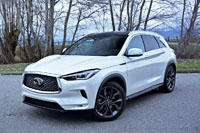
Hey good lookin’! Yes, Infiniti’s been slow cookin’ its redesigned QX50 recipe for years, but now that the all-new 2019 model is on the road and looking sensational, I can only see success in its future.
The proof is in the pudding, so to speak, and now with this new model’s first partial year in its rearview mirror, and YoY Canadian sales growth up 59 percent as of December 31, plus an even more impressive 113.7-percent two-month gain as of February’s final tally, it’s clear that Canada’s compact luxury crossover buyers like what they see.
These newfound QX50 buyers are no doubt falling for the entire QX50 package as much as for its inspiring styling, plus its considerably more modernized and therefore more appealing interior design, its higher quality materials, as well as its wholly improved electronics interface package, and while the original was particularly good on pavement, this second-generation redesign is no slouch off-the-line or around corners either, which is critically important in the premium sector. But does it fully measure up?
Now that the much-loved FM platform, having served 11 years in the outgoing model, is done and dusted in this category, much to the chagrin of performance-focused drivers who loved its rear-drive bias and wonderful overall balance, this small but ardent following is reluctantly forced to say hello to a totally new front-wheel drive based layout, which while standard with all-wheel drive here in Canada, provides a different feel that may cause some previous QX50 owners a moment of pause.

Still, with most manufacturers moving away from rear-drive architectures due to interior packaging restrictions, something Audi and Acura have known for more than a decade and likely one reason their compact SUVs continually outsell most competitors, with this layout configuration also being adopted by BMW for its latest X1, it was only a matter of time that Infiniti’s second-most popular model adapted to changing times.
So what’s the result of Infiniti’s wholesale change in QX50 direction? Think QX60, only smaller. What I mean is, this latest version of Infiniti’s compact crossover provides a more comfortable ride than its predecessor, that floats more smoothly over bridge expansions and other pavement imperfections, and similarly delivers greater quietness inside (due in part to active engine mounts plus acoustic windshield and side window glass) for a more refined overall luxury experience, but it’s certainly nowhere near the performance SUV the outgoing model was.
Where the rear-drive-biased first-gen 2008–2017 (there was no 2018 model) QX50 (née EX35) felt like a performance-oriented sport sedan in a taller crossover body, which essentially it was, this new version feels more like the Nissan Altima/Murano-based front-wheel drive-derived design it’s based on, despite having all the hardware (and software) boxes checked, such as a fully independent front strut and rear multi-link suspension setup, and standard Active Trace Control that automatically adds brake pressure mid-corner to help maintain a chosen lane. Still, it’s a bit less rooted to the tarmac at high speeds, especially around bumpy corners, and also somewhat less confidence inspiring when pushed hard down the open freeway. There’s a reason the world’s best performance vehicles are based on rear-wheel drive platforms after all, and the QX50’s swap to a front-wheel drive biased architecture makes this truth clearly evident.
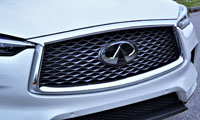
The new variable compression turbo engine is superb, however, with a lot more usable power from its diminutive displacement than most competitors’ base engines. Its 2.0-litre size is identical to the majority of rivals, yet its 268 horsepower and 280 lb-ft of torque is considerably more potent than the entry four-cylinder from the compact luxury SUV market segment’s best-selling Mercedes-Benz GLC, for example, which puts out just 241 horsepower and 273 lb-ft of torque, or the next most popular Audi Q5’s 248 hp and 273 lb-ft (or the base Porsche Macan that uses the same engine as the Q5), or for that matter the third-place BMW X3’s 248 hp and 258 lb-ft, while it’s easily more formidable than Lexus’ NX that’s only rated at 238 hp and 258 lb-ft of torque, not to mention Cadillac’s new XT4 that merely musters 237 hp and 258 lb-ft, but this said it’s a fraction off the new Acura RDX that makes 272 hp and 280 lb-ft, as well as the Alfa Romeo Stelvio that leads the segment’s base powerplants with 280 hp and 306 lb-ft of torque.
The WardsAuto 10 Best Engines-winning VC-Turbo’s technology took Infiniti’s engineering team a full four years to develop, and incorporates special connecting rods between its pistons and crankshaft that vary the compression of the fuel and air mixture, less for increasing power output when needed and more during lower loads like cruising and coasting for improving fuel efficiency.
Another 2019 QX50 differentiator that might miff previous owners, unless they’re from the left coast where pump prices are soaring sky high, is the new fuel-friendly continuously variable transmission (CVT). Before getting your back up about the QX50 losing its mostly quick-shifting seven-speed automatic, take note this isn’t any ordinary run-of-the-mill CVT, but rather an all-new shift-by-wire design that includes manual shift mode, steering wheel paddles, Downshift Rev Matching (that blips the throttle to match a given gear ratio with engine rpms), plus dual transmission fluid coolers, and I must say it’s one of the more normal feeling CVTs I’ve tested to date.
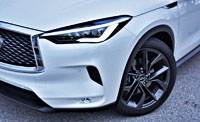
It only exposes the artificial nature of its stepped gears when pressing hard on the throttle, a process that spools up power and torque quickly, albeit allows revs to hold a little too high for a bit too long, which hampers performance, refinement and fuel economy. This said it responds quite well to input from those just noted paddle shifters, and feels especially energetic in Sport mode, but I won’t go so far as to say it’s as engaging as its predecessor’s gearbox, nor as lickety-split quick as competitor’s traditional multi-speed automatics.
Then again when driven more modestly, like most of us do with our family haulers, it’s a silky smooth transmission that provides the QX50 with more than enough day-to-day performance plus much better claimed fuel economy at 10.0 L/100km in the city, 7.8 on the highway and 9.0 combined, compared to 13.7 city, 9.8 highway and 11.9 combined for the previous V6-powered model, which incidentally is a 30-percent improvement.
Back on the negative, Infiniti’s Eco mode continues to be my least favourite in the industry, due only to the Eco Pedal that annoyingly pushes back on the right foot to remind you not to press hard on the gas pedal. The problem with this intrusive-nanny solution is that people like me, who hate it, simply won’t use Eco mode at all (you can’t turn the Eco Pedal off separately), which defeats the purpose of having an Eco mode in the first place. So therefore, I only used the QX50’s Eco mode once for testing purposes, and after realizing the Eco Pedal was just as intrusive as it’s always been, immediately turned it off, whereas if I were driving a Mercedes-Benz GLC, Audi A5, BMW X3 or anything else in the class, I would have left Eco mode on more often than not in order to save fuel and reduce emissions.
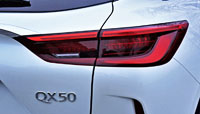
Eco mode, and all driving modes are set via a nicely crafted “D-MODE” labeled metal rocker switch on the lower console, just behind the QX50’s completely new electronic shift lever, a small stub of its previous self, yet very well made from satin-silver aluminum and contrast stitched leather. Thank goodness it’s not a row of confusing buttons like some rivals, other than a small “P” for park when arriving at your destination.
Switchgear in mind, a beautifully detailed knurled metal-edged rotating infotainment controller is placed just above the shifter on a separate section of the lower console, while the door-mounted power window switches receive attractive metal adornment too. All of the cabin’s other buttons, knobs and switches are quality pieces made from densely constructed composites and metals, while they’re also well damped with tight tolerances, the new QX50 easily living up to this premium class status and beyond when it comes to these details and some of the other surface treatments too.
For instance, an assortment of satin-silver aluminum trim can be found decorating the rest of the interior, the geometrically drilled Bose speaker grilles especially rich, while gorgeous open-pore natural maple hardwood inlays (exclusive to this Sensory model) joined plush black ultrasuede (also a Sensory exclusive) across door uppers, the latter two treatments added to the instrument panel, centre stack and lower console, plus the front seat bolsters, while contrast-stitched leather was also placed next to the ultrasuede in all of the same locations for truly opulent surroundings. Infiniti even wrapped the first and second set of roof pillars, and lined the ceiling in the same soft yet durable suede-like fabric, the latter also benefiting from a large dual-panel powered panoramic glass sunroof.
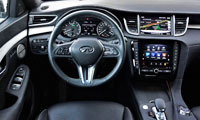
All in all the new QX50’s interior is one of the best in its class, with mostly pliable synthetics above the waist, including soft-touch paint used for the glove box lid. Infiniti didn’t gone so far as to finish the bottom portion of the centre console or the lower door panels in such pampering pliable plastics, or for that matter the lower portion of the dash ahead of the driver, with the compact luxury segment’s usual hard composite surfaces starting just underneath the hardwood trim on the left of the steering wheel, and below the leather padding to the right. Still, it’s an interior both Infiniti and you can be proud of, beating many of the industry leaders at their own ultra-luxe game.
As the kinesthetically-inspired trim designation implies, this $56,490 Sensory model is mostly about creature comforts, and while including all features already noted it also adds premium-grade semi-aniline leather upholstery, two-way front passenger powered lumbar support, three-way ventilated front seats, advanced climate control, extended interior ambient lighting, rear side window sunshades, a motion activated liftgate, and metallic cargo area finishers, while exterior upgrades include 20-inch dark tinted alloys on 255/45 all-season run-flat tires, plus unique cube design LED high/low beam headlamps with adaptive cornering capability.
There is one trim above Sensory, but the $57,990 Autograph won’t be to everyone’s tastes due a special blue-hued ultrasuede replacing the black found in the Sensory model, plus white surfacing used for much of the instrument panel, centre console sides, door inserts and seats, the centre inserts of the latter boasting diamond-quilted semi-aniline leather, plus blue piping between the white leather and blue ultrasuede.
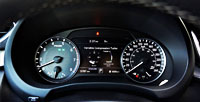
Both Autograph and as-tested Sensory models pull plenty of equipment up from $52,990 ProActive trim, such as automatic high beams, adaptive cruise control with full speed range and hold, distance control assist, lane departure warning and prevention, blindspot intervention, rear cross-traffic alert, backup collision intervention, steering assist, ProPilot Assist semi-autonomous self-driving, Infiniti’s exclusive steer-by-wire Direct Adaptive Steering system (a first for an Infiniti SUV) that works very well (other trims use vehicle-speed-sensitive power steering), a head-up display, and a 16-speaker Bose Premium Series audio system.
Likewise, a host of features from the $48,990 Essential enhance our Sensory model too, including rain-sensing wipers, front and rear parking sensors, reverse tilting side mirrors, Infiniti’s superb 360-surround Around View parking monitor with moving object detection, navigation with detailed mapping, tri-zone automatic climate control with rear-seat switchgear (upgraded from the base model’s dual-zone auto system), a powered tilt and telescopic steering column, plus memory for that steering wheel as well as for the front seats and side mirrors.
Finally, the $44,490 base Luxe model adds LED fog lamps, LED integrated turn signals on outside mirror housings, LED taillights (it comes standard with LED low/high beam headlights too), chrome-accented exterior door handles, dual chrome exhaust tips, remote engine start, proximity-sensing keyless access with pushbutton ignition, the aforementioned drive mode selector with standard, eco, sport, and personal settings, the powered panoramic glass sunroof including a powered sunshade, a powered liftgate, predictive forward collision warning, forward emergency braking with pedestrian detection, blindspot warning, and more.
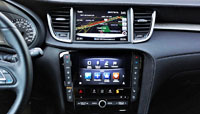
Take note that all 2019 QX50 pricing for trims, packages, and standalone options were sourced right here on CarCostCanada, and don’t forget that we can also provide you with money-saving manufacturer rebate information, plus otherwise hard to get dealer invoice pricing that could save you thousands when it comes time to negotiate your deal.
Also standard with all QX50 trims is Infiniti’s new InTouch dual-display infotainment system featuring a beautifully bright and clear high-definition 8.0-inch monitor on top and an equally impressive 7.0-inch touchscreen below that, plus InTouch safety, security and convenience services, etcetera. This is an easy system to use, with all hands-on functionality found within the bottom screen and the top monitor mostly dedicated to the navigation system and backup/surround camera system, which displays both for optimal safety.
Digitization in mind, I was a bit surprised that Infiniti stuck with its mostly analogue gauge cluster in this entirely new model, being that most competitors are now anteing up with fully digital designs in top trims. Then again the QX50 partially makes up for this shortcoming with a large colour multi-information display that’s full of useful functions, controlled by an easily sorted array of switchgear on the steering wheel spokes.
While I’m talking up the positives, I’ve got to give Infiniti kudos for removing the intrusive nosepiece from their sunglasses holder. I never understood why the previous version was too large to hold a regular set of glasses in place, but fortunately this new one is much more accommodating because it doesn’t including a nosepiece holder at all.
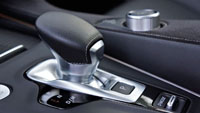
Now that I’m getting down to the nitty-gritty practical stuff, the new QX50 is also much roomier, especially for rear passengers that now benefit from quite a bit more leg and headroom. In fact, Infiniti claims that its rear seat space is greater than the previously noted Audi Q5 and BMW X3, while those back seats now slide fore and aft for more cargo space or better legroom respectively.
I found the rear seat extremely comfortable, with plenty of room for my knees, at least eight inches when my seat was set up for my five-foot-eight long-legged, short-torso frame, plus adequate floor space to move around my feet when wearing boots, although not much of a gap below the driver’s seat. I could definitely feel the compact QX50’s width compromise, with not a great deal of air space next to my left knee, but at least the door armrest was padded, and there was ample room for my outboard shoulder. Your adult rear passengers may find the centre armrest a little bit low, but it should be ideal for kids, and there’s a slot for a cellphone as well as two rubberized cupholders that should hold drinks in place. The aforementioned rear climate control panel, which only includes a tiny monochromatic LCD display and colour-coded rocker switch for adjusting the temperature, is joined by a USB device charger and 12-volt socket, but strangely omits rear seat heaters that aren’t available with the QX50 at all.

Yes, this is a strange omission in a market that has been experiencing colder winters over the past two years, and could potentially turn off some buyers that want their kids and/or parents to be as comfortable as possible year-round.
It’s cargo capacity won’t be a negative, however, being that it’s grown by 368 litres (13.0 cubic feet) to 895 (31.6 cu ft) behind its 60/40 split-folding rear seatbacks, even when they’re pushed all the way rearward, while sliding the back bench as far forward as possible adds another 153 litres (5.5 cu ft) of gear toting capacity for a total volume of 1,048 litres (37.0 cu ft) when both rows are occupied. Fold the second-row seats flat and cargo space expands to 1,822 litres (64.3 cu ft), and by the way, Infiniti provides handy levers on the sidewalls for doing just that. Why all this is difficult to fault, I would have appreciated a centre pass-through for loading longer items such as skis down the middle, leaving the two more comfortable window seats available when heading to the slopes. Better yet, Euro-style 40/20/40-split rear seats would allow even larger boards between rear occupants; food for future Infiniti thought.

The powered liftgate is programmable for height, which is a good thing if you live in a parking garage that requires such things, but not so good if you keep smacking your head into it and don’t take the time to reprogram (not Infiniti’s fault), while the cargo compartment is finished quite nicely, with an aluminum sill guard and the usual carpeting up the sidewalls and on the backside of the seats, plus the floor of course, the latter removable to expose the audio system’s amplifier and subwoofer plus a bit of space in between, and another shallow compartment just behind, for stowing smaller items.
As practical, wonderfully crafted, efficient and quick as the new QX50 is, styling will be the determining factor for most would-be buyers, at least initially. I find its front end especially attractive, with Infiniti’s double-arch grille positioned below a long, elegantly sculpted hood, and flanked by an eye-catching set of signature LED headlamps over a clean, sporty lower fascia.
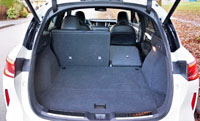
Organically shaped panels flow rearward down each side, passing by a nicely detailed chrome engine vent garnish on the upper front fenders, a metal brightwork adorned greenhouse finalizing with Infiniti’s trademark kinked rear quarter windows, and around the back where a particularly appealing rear end design features nicely shaped LED taillights, while a variety of 19- to 20-inch alloy wheels round out the design depending on trim. For me it’s a winner, but time will tell whether it manages to conquest enough new buyers away from rival brands to truly deem it an unqualified success.
Story credit: Trevor Hofmann
Photo credit: Karen Tuggay
